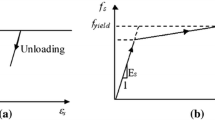Abstract
The instantaneous and creep and shrinkage behaviour of composite steel-concrete sections subjected to axial load and biaxial bending is examined analytically using the age-adjusted effective modulus method and a stress relaxation procedure. Any cross-section that can be discretized in rectangular elements can be analysed using the approach described in this study. Material non-linearities (concrete cracking and crushing as well as steel yielding) are included in the formulation by empolying an interative numerical procedure. The analytical method was implemented in a computer program and case studies demonstrate that composite columns under complex loads experience a considerable redistribution of stresses and strains, causing the degree of cracking and the secondary load effects (P-delta) to increase.
Resume
On a procédé à l'étude de la réaction instantanée et du comportement en fluage et retrait de sections acier-béton sous charge axiale et en flexion bi-axiale par la méthode du module réel en fonction de l'âge et une méthode de relaxation des contraintes. Dans cette étude, on présume que l'adhérence entre le béton et l'acier est parfaite, et peut s'appliquer à n'importe quelle section transversale décomposée en éléments rectangulaires. Les non-linéarités du matériau (fissuration et écrasement du béton, écoulement de l'acier) sont prises en compte dans la formulation par l'utilisation d'un traitement numérique itératif, qui consiste à transformer l'analyse inélastique en une équivalence élastique.
La méthode analytique est entièrement automatisée par ordinateur (la mise en oeuvre) et les études de cas démontrent que, sous des charges complexes, il se produit dans les colonnes composites une importante redistribution des contraintes et déformations qui augmente le taux de fissuration et les effets de charge secondaires (P-delta). D'autres résultats montrent qu'un gain de la part d'acier dans les colonnes composites détermine une réducation du taux de déformation avec le temps. De plus, il se vérifie qu'en répartissant l'acier au voisinage du périmètre des sections composites, on obtient un système mieux conçu (courbures réduites) pour résister aux charges axiales en combinaison avec les moments bi-axiaux.
On pense que la formulation présentée dans cette étude repose sur une base théorique saine et peut être utilisée pour une meilleure compréhension du comportement en service d'éléments composites sous l'influence de charges plus complexes que celles pratiquées dans la littérature.
Similar content being viewed by others
References
Neville, A. M., Dilger, W. H. and Brooks, J. J., ‘Creep of Plain and Structural Concrete’ (Construction Press, Longman Group, 1983).
Ghali, A. and Favre, R., ‘Concrete Structures: Stresses and Deformations’, (Chapman & Hall, London, 1986).
Gilbert, R. I., ‘Time Effects in Concrete Structures’ (Elsevier Science, Amsterdam, 1988).
Comité Euro-International Du Béton, ‘CEB-FIP Model Code for Concrete Structures’, Bulletin D'Information N. 124/125-E-CEB-FIP (1978).
ACI Committee 209, Subcommittee II, ‘Prediction of creep, shrinkage and temperature effects in concrete structures’, Final Report (American Concrete Institute, 1982).
Faber, O., ‘Plastic yield, shrinkage and other problems of concrete and their effects on design’,Proc. Inst. Civ. Engrs, London,225 (1) (1927) 27–73.
Trost, H., ‘Auswirkungen des Superpositionsprinzips auf Kriech- und Relaxations-Probleme bei Beton und Spannbeton’,Beton Stahlbetonbau 62 (10) (1967) 230–238.
Idem 62 (11) (1967) 261–269.
Bazant, Z. P., ‘Prediction of concrete creep effects using age-adjusted effective modulus method,’J. Amer. Concr. Inst. 69 (4) (1972) 212–217.
Glanville, W. H., ‘Studies in reinforced concrete-III, The creep or flow of concrete under load’,Building Research Technical Paper No. 12 (Department of Scientific and Industrial Research, London, 1930).
Whitney, C. S., ‘Plain and reinforced concrete arches’,J. Amer. Concr. Inst. 28 (1932) 479–519.
Dischinger, F., ‘Untersuchungen über die Knicksicherheit, die elastische Verformung und das Kriechen des Betons bei Bogenbrucken’,Der Bauingenieur 18(33/34) (1937) 487–520.
Idem, ibid. 18(35/36) (1937) 539–552.
Idem, ibid. 18(39/40) (1939) 595–621.
Nielsen, L. F., ‘Kriechen und Relaxation des Betons’,Beton Stahlbetonbau 65 (1970) 272–275.
Bridge, R. Q., ‘Composite columns under sustained load,’J. Struct. Div. ASCE 105(ST3) (1979) 563–576.
Watanabe, E., Hayashi, K., Takenaka, H., Fujii, M. and Nakai, H., ‘Creep in precast concrete composite girders’, in ‘Composite Construction in Steel and Concrete’, edited by C. D. Buckner and I. M. Vest (ASCE, 1987) pp. 541–560.
Gilbert, R. I., ‘Time-dependent analysis of composite steel-concrete sections’,J. Struct. Engrg. ASCE 115(11) (1989) 2697–2705.
Bradford, M. A. and Gilbert, R. I., ‘Time-dependent analysis and design of composite columns’,116(12) (1990) 3338–3357.
Park, R. and Paulay, T., ‘Reinforced Concrete Structures’ (Wiley, New York, 1975).
Bresler, B. and Selna, L., ‘Analysis of time dependent behaviour of reinforced concrete structures’, in ‘Symposium on Creep of Concrete’, ACI Special Publication SP-9, (5) (1964) pp. 115–128.
Gilbert, R. I. ‘Time-dependent behaviour of structural concrete slabs’, PhD thesis, University of New Wouth Wales, Australia.
Adrian, C. A. ‘Time-dependent analysis of composite steel-concrete structures under axial loads and biaxial bending’, MSc thesis (1991), Massachusetts Institute of Technology.
Author information
Authors and Affiliations
Rights and permissions
About this article
Cite this article
Adrian, C.A., Triantafillou, T.C. Creep and shrinkage analysis of composite systems under axial load and biaxial bending. Materials and Structures 25, 543–551 (1992). https://doi.org/10.1007/BF02472450
Issue Date:
DOI: https://doi.org/10.1007/BF02472450




